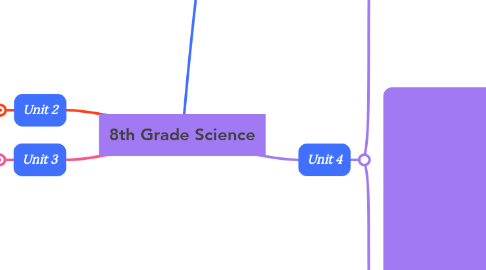
1. Unit 2
1.1. Module 1
1.1.1. Lesson 1
1.1.1.1. Reference Point
1.1.1.2. Position
1.1.1.3. Displacement
1.1.1.4. Speed
1.1.1.5. Average Speed
1.1.1.6. Velocity
1.1.1.7. Vector
1.1.1.8. . Distance Time grpahs
1.1.2. Lesson 2
1.1.2.1. Acceleration
1.1.2.2. Forces
1.1.2.3. Contact forces
1.1.2.4. Newtons 2nd law of motion
1.1.2.5. Friction
1.1.2.6. Free body diagram
1.1.2.7. Net force
1.1.2.8. Newtons 1st law of motion
1.1.3. Lesson 3
1.1.3.1. Newtons 3rd law of motion
1.1.3.2. Force Pairs
1.1.3.3. Normal Force
1.1.3.4. Collision Forces
1.1.3.5. Elastic collision
1.1.3.5.1. .
1.1.3.6. Inelastic collision
1.1.4. Lesson 4
1.1.4.1. Noncontact forces
1.1.4.2. Gravitational Force
1.1.4.3. Gravitational field
1.1.4.4. Gravitational Force and Mass
1.1.4.5. Gravitational force distance
1.1.4.6. Gravity in our solar system
1.1.4.7. Gravitational Acceleration
1.1.4.8. Weight
1.1.4.9. General Relativity
1.2. Modlule 2
1.2.1. lesson 1
1.2.1.1. Kinetic energy
1.2.1.2. Kinetic energy and mass
1.2.1.3. Kinetic energy and speed
1.2.2. Lesson 2
1.2.2.1. Potetional energy
1.2.2.2. Elastic Potential energy
1.2.2.3. Gravitational potetional energy
1.2.3. Lesson 3
1.2.3.1. Mechanical energy
1.2.3.2. Changes between kinetic and potential energy
1.2.3.3. Conservation of energy
1.2.3.4. Work
1.2.3.5. Thermal energy transformations
1.3. Module 3
1.3.1. Lesson 1
1.3.1.1. Magnet
1.3.1.2. Ferromagnetic elements
1.3.1.3. Magnetic force
1.3.1.4. Magnetic poles
1.3.1.5. Magnetic Fields
1.3.1.6. Compasses
1.3.1.7. Magnetic strength
1.3.1.8. Magnetic Potential Energy
1.3.1.9. Transferring Magnetic Potential Energy
1.3.1.10. Magnetic Domain
1.3.1.11. Nonmagnetic Materials
1.3.1.12. Magnetic Matierials
1.3.1.13. Temporary Magnet
1.3.1.14. Permanent Magnets
1.3.2. Lesson 2
1.3.2.1. Charges
1.3.2.2. Electric Field
1.3.2.3. Electric Field strength
1.3.2.4. Electric Potential Energy
1.3.2.5. Electrically Charged Objects
1.3.2.6. Electrically Neutral
1.3.2.7. Induction
1.3.2.8. Electric Insulator
1.3.2.9. Electric conductor
1.3.2.10. Conduction
1.3.2.11. Conservation of Charge
1.3.3. Lesson 3
1.3.3.1. Simple circuit
1.3.3.2. Closed Circuit
1.3.3.3. Open circuit
1.3.3.4. CHarged Particles
1.3.3.5. Electric Current
1.3.3.6. Voltage
1.3.3.7. Energy
1.3.4. Lesson 4
1.3.4.1. Electromagnetism
1.3.4.2. Electric current magnetc field
1.3.4.3. Increasing magnetic field strength
1.3.4.4. Controlling electromagnets
1.3.4.5. Electric motor
1.3.4.6. Generating electric current
1.3.4.7. Electric generator
1.3.4.8. Mechanical to electric energy
1.3.4.9. Direct Current (DC)
1.3.4.10. Alternating current
2. Unit 3
2.1. Module 1
2.1.1. Lesson 1
2.1.1.1. Wave
2.1.1.2. Vibration
2.1.1.3. Transverse wave
2.1.1.4. Mechanical wave
2.1.1.5. Water Waves
2.1.1.6. Medium
2.1.1.7. Longitudal waves
2.1.1.8. Wavelength
2.1.1.9. Sound waves
2.1.1.10. Amplitude
2.1.1.11. Intensity
2.1.1.12. Decibel
2.1.1.13. Frequency
2.1.1.14. Pitch
2.1.2. Lesson 2
2.1.2.1. Reflection
2.1.2.2. Absorption
2.1.2.3. Transmission
2.1.2.4. Diffraction
2.2. Module 2
2.2.1. Lesson 1
2.2.1.1. Light
2.2.1.2. Radiant energy
2.2.1.3. Light energy
2.2.1.4. Light brightness
2.2.1.5. Speed of light
2.2.1.6. Light sources
2.2.1.7. Transparent
2.2.1.8. Transclucent
2.2.1.9. Opaque
2.2.1.10. Reflection
2.2.2. Lesson 2
2.2.2.1. Law of reflection
2.2.2.2. Virtual image
2.2.2.3. Concave mirrors
2.2.2.4. Focal point
2.2.2.5. Convex mirror
2.2.2.6. Real Image
2.2.2.7. Refular Reflection
2.2.2.8. DIffuse Reflection
2.2.2.9. Scattering
3. Unit 1
3.1. Module 0
3.1.1. Section 1
3.1.1.1. Scientific Method
3.1.1.1.1. Observation
3.1.1.1.2. Questions
3.1.1.1.3. Hypothesis
3.1.1.1.4. Prediction
3.1.1.1.5. Test the Prediction
3.1.1.1.6. Quantitative observations
3.1.1.1.7. Qualitative observations
3.1.1.1.8. Iterative process
3.1.1.1.9. Publish/Peer Review
3.1.2. Section 2
3.1.2.1. CER
3.1.2.1.1. Claim
3.1.2.1.2. Evidence
3.1.2.1.3. Reasoning
3.1.3. Section 4
3.1.3.1. Graph Trends Ppt
3.1.3.1.1. Dry
3.1.3.1.2. Mix
3.1.3.1.3. LENSES
3.1.4. Section 5
3.1.4.1. Lab safety
3.1.4.1.1. Hair in a lab
3.1.4.1.2. Clothing in a lab
3.1.4.1.3. Footwear in a lab
3.1.4.1.4. Protective glasses
3.1.4.1.5. Colors of Health Hazard symbols
3.1.4.1.6. MSDS
3.1.4.1.7. Pipetting
3.2. Module 1
3.2.1. Lesson 1
3.2.1.1. Geologic Time
3.2.1.1.1. Uniformitarianism
3.2.1.1.2. Absolute Age
3.2.1.1.3. Relative-age Dating
3.2.1.1.4. Sediment
3.2.1.1.5. Strata
3.2.1.1.6. Relative Age
3.2.1.1.7. Superposition
3.2.1.1.8. Original horizontality
3.2.1.1.9. Lateral Continuity
3.2.1.1.10. Inclusions
3.2.1.1.11. Cross cutting relationships
3.2.1.1.12. The Fossil Record
3.2.1.1.13. Mass Extinctions
3.2.2. Lesson 2
3.2.2.1. Geologic time line
3.2.2.1.1. Unconformities
3.2.2.1.2. Correlation
3.2.2.1.3. Index fossils
3.2.2.1.4. Key bed
3.2.2.1.5. Geologic time scale
3.3. Module 2
3.3.1. Lesson 1
3.3.1.1. Genetics
3.3.1.1.1. Important people
3.3.1.1.2. DNA Double helix
3.3.1.1.3. DNA Nucleotides
3.3.1.1.4. Nitrogenous Bases
3.3.1.1.5. Complementary Bases
3.3.1.1.6. DNA Models
3.3.1.1.7. How Much DNA?
3.3.1.1.8. DNA replication
3.3.1.1.9. DNA Errors
3.3.1.1.10. Random Vocab
3.3.1.1.11. RNA
3.3.1.1.12. Semi-Conservative Replication
3.3.1.1.13. Leading Strand
3.3.1.1.14. Lagging Strand
3.3.2. Lesson 2
3.3.2.1. Evolution
3.3.2.1.1. Charles Darwin
3.3.2.1.2. Natural selection
3.3.2.1.3. survival of the fittest
3.3.2.1.4. Common ancestors
3.3.2.1.5. Genetic Variation
3.3.2.1.6. Adaptions, and its types
3.3.2.1.7. Enviormental Interactions(camo-mimicry)
3.3.2.1.8. Modern theory of evolution
3.3.3. Lesson 3
3.3.3.1. Artificial Selection
3.3.3.1.1. Selective Breeding
3.3.3.1.2. Genetic Engineering
3.3.3.1.3. Genetically modified organisms
3.4. Module 3
3.4.1. Lesson 1
3.4.1.1. Fossils Evidence of Evolution
3.4.1.1.1. Fossil Formation
3.4.1.1.2. Mineralization
3.4.1.1.3. Carbonization
3.4.1.1.4. Molds and Casts
3.4.1.1.5. Trace Fossils
3.4.1.1.6. Original Material
3.4.1.1.7. Fossil Record
3.4.1.1.8. Geologic Time Scale
3.4.1.1.9. Extinctions
3.4.1.1.10. Sudden Environmental Change
3.4.1.1.11. Gradual Environmental Changes
3.4.1.1.12. Transitional Fossil
3.4.2. Lesson 2
3.4.2.1. Biological Evidence of evolution
3.4.2.1.1. Comparative Anatomy
3.4.2.1.2. Homologous Structures
3.4.2.1.3. Analougous Structures
3.4.2.1.4. Vestigial Structures
3.4.2.1.5. Embryology
3.4.2.1.6. Molecular Biology
4. Unit 4
4.1. Module 1
4.1.1. Lesson 1
4.1.1.1. Population
4.1.1.2. Natural Resource
4.1.1.3. Carrying capacity
4.2. Module 2
4.2.1. Lesson 2
4.2.1.1. The Moon
4.2.1.2. Lunar Phase
4.2.1.3. waxing phases
4.2.1.4. Waning phases
4.2.1.5. Full cycle
